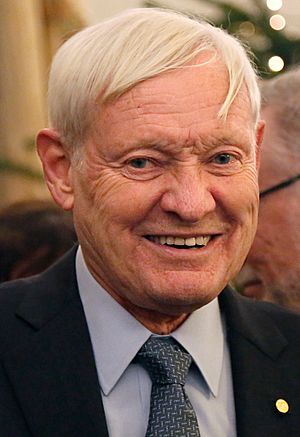Joachim Frank facts for kids
Quick facts for kids
Joachim Frank
|
|
|---|---|

Joachim Frank under Nobel Prize press conference in Stockholm, December 2017
|
|
| Born | September 12, 1940 |
| Citizenship | United States, Germany |
| Education | University of Freiburg (BS) University of Munich (MS) Max Planck Society Technical University of Munich (PhD) Cornell University |
| Known for | Single-particle cryo-electron microscopy Ribosome structure and dynamics |
| Spouse(s) |
Carol Saginaw
(m. 1983) |
| Children | Ze Frank & Mariel Frank |
| Awards |
|
| Scientific career | |
| Fields | Structural biology Cryo-electron microscopy |
| Institutions | University at Albany, Department of Biomedical Sciences Columbia University College of Physicians and Surgeons, Department of Biochemistry and Molecular Biophysics |
| Thesis | Untersuchungen von elektronenmikroskopischen Aufnahmen hoher Auflösung mit Bilddifferenz- und Rekonstruktionsverfahren (1970) |
| Doctoral advisor | Walter Hoppe |
| Other academic advisors | Robert Glaeser, Robert Nathan |
Joachim Frank (born September 12, 1940) is a German-American biophysicist. He works at Columbia University in the United States. He is famous for his work on a special type of microscope called single-particle cryo-electron microscopy, often called cryo-EM. This amazing method lets scientists see tiny molecules in great detail. For this important discovery, he won the Nobel Prize in Chemistry in 2017. He shared the prize with two other scientists, Jacques Dubochet and Richard Henderson. Joachim Frank also helped us understand the structure and movement of ribosomes. Ribosomes are like tiny factories inside cells that make proteins.
Contents
Life and Education
Joachim Frank was born in Siegen, Germany. He loved science and studied physics at the University of Freiburg. He then continued his studies at the Ludwig Maximilian University of Munich. In 1970, he earned his PhD from the Technical University of Munich. His research focused on using computers to improve images from electron microscopes. This early work was very important for his later discoveries.
After his PhD, Joachim Frank moved to the United States. He worked at different research centers, including the Jet Propulsion Laboratory and the University of California, Berkeley. He also spent time at Cornell University. These experiences helped him learn more about electron microscopy. In 1973, he moved to the University of Cambridge in England for a short time.
Developing Cryo-Electron Microscopy
In 1975, Joachim Frank joined the New York State Department of Health. This is where he began his groundbreaking work on single-particle electron microscopy. This method allows scientists to study individual tiny particles. It was a big step forward in seeing very small things.
Later, he became a professor at the University at Albany. He continued to develop his microscopy techniques. His work made it possible to create clear 3D images of biological molecules. These molecules are too small to see with regular microscopes. In 2008, he joined Columbia University as a professor. His research there has continued to push the boundaries of what we can see in the microscopic world.
Major Awards and Recognition
Joachim Frank has received many important awards for his scientific contributions.
- 2014: He was awarded the Benjamin Franklin Medal in Life Science. This award recognizes great achievements in science.
- 2017: He received the Wiley Prize in Biomedical Sciences.
- 2017: The most famous award he received was the Nobel Prize in Chemistry. This prize recognized his work in developing cryo-electron microscopy. This method has changed how scientists study life at a molecular level.
- 2018: He was made an Honorary Fellow of the Royal Microscopical Society.
His discoveries have helped scientists understand how diseases work. They also help in developing new medicines.
See also
 In Spanish: Joachim Frank para niños
In Spanish: Joachim Frank para niños

